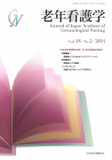Japanese
English
- 販売していません
- Abstract 文献概要
- 参考文献 Reference
抄録
本研究の目的は,高齢男性の回復期脳卒中片麻痺患者において,排尿援助方法によって非麻痺側筋肉量の変化に違いがでるのかを明らかにすることである.
65歳以上の回復期脳卒中片麻痺患者14人を対象に,入院2週目と3か月目に排尿援助の調査および非麻痺側筋肉量の測定をした.その結果,尿意のある患者は,全員が車いすで移動し,トイレでの排尿を行っていた.一方で,尿意があいまいもしくはない患者は,全員が排尿に伴う移動はなく,オムツもしくは膀胱留置カテーテルでの排尿を行っていた.トイレで排尿を行っていた患者(筋肉量4.30±1.02kg,増加量0.04±0.61kg)は,そうでない患者(筋肉量3.69±0.58kg,増加量−0.14±0.86kg)に比べ,有意に非麻痺側下肢筋肉量が大きく(p=0.014),入院中の非麻痺側下肢筋肉量の増加量も大きい傾向(p=0.094)があった.
介助を受けながらであっても,立位保持が促される排尿援助を受けることにより,非麻痺側下肢筋肉量の維持・向上につながる可能性が示唆された.
The present study examined whether or not varying methods of urinary support provided for elderly male patients with stroke-induced hemiplegia in the convalescent phase causes differences in the change in muscle mass on the non-paralyzed side.
The subjects were fourteen patients aged 65 years or older with stroke-induced hemiplegia in the convalescent phase. A survey of urinary support and measurement of the muscle mass on the non-paralyzed side were conducted twice: two weeks and three months after hospitalization. The results suggested that when patients had an urge to urinate, they all went to the bathroom using a wheelchair. On the other hand, patients who had little or no urge to urinate used a diaper or indwelling bladder catheter, and did not go to the bathroom. The leg muscle mass on the non-paralyzed side (p=0.014) and its increase during hospitalization (p=0.094) were significantly larger in patients who used the bathroom (muscle mass: 4.30 ± 1.02kg, increase: 0.04 ± 0.61kg), compared to those who did not (muscle mass: 3.69 ± 0.58kg, increase: -0.14 ± 0.86kg).
Urinary support for elderly males, which encourages male patients, including those requiring assistance, to stand erect, may help maintain and increase the leg muscle mass on the non-paralyzed side.
Copyright © 2014, Japan Academy of Gerontological Nursing All rights reserved.


